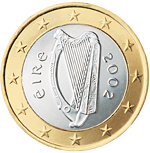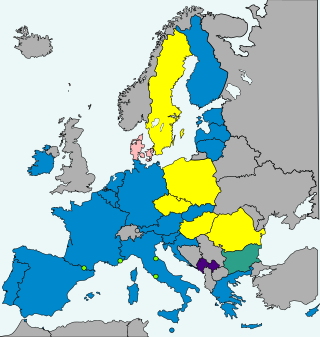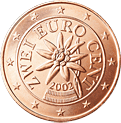There are eight euro coin denominations, ranging from one cent to two euros. The coins first came into use in 2002. They have a common reverse, portraying a map of Europe, but each country in the eurozone has its own design on the obverse, which means that each coin has a variety of different designs in circulation at once. Four European microstates that are not members of the European Union use the euro as their currency and also have the right to mint coins with their own designs on the obverse side.
Belgian euro coins feature only a single design for all eight coins: the portrait or effigy of the King of the Belgians. Previously, all Belgian euros depicted King Albert II and his royal monogram. Current coins depict King Philippe. Also part of the design by Jan Alfons Keustermans are the 12 stars of the EU and the year of imprint.
German euro coins have three separate designs for the three series of coins. The 1-cent, 2-cent and 5-cent coins were designed by Rolf Lederbogen, the design for the 10-cent, 20-cent and 50-cent coins were designed by Reinhard Heinsdorff and the 1- and 2-euro coins were done by Heinz Hoyer and Sneschana Russewa-Hoyer. Featured in all designs are the 12 stars of the EU and the year of minting.
Greek euro coins feature a unique design for each of the eight coins. They were all designed by Georgios Stamatopoulos with the minor coins depicting Greek ships, the middle ones portraying famous Greeks and the two large denominations showing images of Greek history and mythology. All designs feature the 12 stars of the EU, the year of imprint and a tiny symbol of the Bank of Greece. Uniquely, the value of the coins is expressed on the national side in the Greek alphabet, as well as being on the common side in the Roman alphabet. The euro cent is known as the lepto in Greek, a name which has also been used for the 1⁄100 denominations of the preceding currencies of the Greek state, the phoenix and drachma.

French euro coins feature three separate designs for the three series of coins. The minor series was designed by Fabienne Courtiade, the middle one by Laurent Jurio and the major two coins are by Joaquin Jimenez. All designs share the 12 stars of the EU and the year of imprint as well as the letters "RF" for République Française.

Irish euro coins all share the same design by Jarlath Hayes, that of the harp, a traditional symbol for Ireland since the Middle Ages, based on that of the Brian Boru harp, housed in Trinity College Dublin. The same harp is used as on the official seals of the Taoiseach, and government ministers and the seal of the president of Ireland. The coins' design also features the 12 stars of the EU, the year of issue and the Irish name for Ireland, "Éire", in a traditional Gaelic script.
Finnish euro coins feature three designs. Heikki Häiväoja provided the design for the 1 cent – 50 cent coins, Pertti Mäkinen provided the design for the 1 euro coin, and Raimo Heino provided the design for the 2 euro coin, which shows cloudberry, the golden berry of northern Finland. All designs feature the 12 stars of the EU and the year of imprint.
Italian euro coins have a design unique to each denomination, though there is a common theme of famous Italian works of art throughout history. Each coin is designed by a different designer, from the 1 cent to the 2 euro coin they are: Eugenio Driutti, Luciana De Simoni, Ettore Lorenzo Frapiccini, Claudia Momoni, Maria Angela Cassol, Roberto Mauri, Laura Cretara and Maria Carmela Colaneri. All designs feature the 12 stars of the EU, the year of imprint, the overlapping letters "RI" for Repubblica Italiana and the letter R for Rome. There are no Italian euro coins dated earlier than 2002, even though they were certainly minted earlier, as they were first distributed to the public in December 2001.

Vatican euro coins are issued by the Philatelic and Numismatic Office of the Vatican City State and minted by Istituto Poligrafico e Zecca dello Stato (IPZS), in Rome, Italy. The euro is the official currency of the Vatican City, although Vatican City is not a member of the Eurozone or the European Union. The euro has been the official currency of Vatican City since 2002. Before that, the Vatican lira was the official currency.
There have been three sets of coins in Ireland since independence. In all three, the coin showed a Celtic harp on the obverse. The pre-decimal coins of the Irish pound had realistic animals on the reverse; the decimal coins retained some of these but featured ornamental birds on the lower denominations; and the euro coins used the common design of the euro currencies. The pre-decimal and original decimal coins were of the same dimensions as the same-denomination British coins, as the Irish pound was in currency union with the British pound sterling. British coins were widely accepted in Ireland, and conversely to a lesser extent. In 1979 Ireland joined the Exchange Rate Mechanism and the Irish pound left parity with sterling; coin designs introduced after this differed between the two countries.

The West Point Mint is a U.S. Mint production and depository facility erected in 1937 near the U.S. Military Academy in West Point, New York, United States. As of 2019 the mint holds 22% of the United States' gold reserves, or approximately 54,000,000 troy ounces (1,700,000 kg). The mint at West Point is second only to the gold reserves held in secure storage at Fort Knox. Originally, the West Point Mint was called the West Point Bullion Depository. At one point it had the highest concentration of silver of any U.S. mint facility, and for 12 years produced circulating Lincoln cents. It has since minted mostly commemorative coins and stored gold.
Slovenian euro coins were first issued for circulation on 1 January 2007 and a unique feature is designed for each coin. The design of approximately 230 million Slovenian euro coins was unveiled on 7 October 2005. The designers were Miljenko Licul, Maja Licul and Janez Boljka. The Mint of Finland was chosen to mint the coins through an international tender in 2007.
Cypriot euro coins feature three separate designs for the three series of coins. Cyprus has been a member of the European Union since 1 May 2004, and is a member of the Economic and Monetary Union of the European Union. It has completed the third stage of the EMU and adopted the euro as its official currency on 1 January 2008.
The coins of Canada are produced by the Royal Canadian Mint and denominated in Canadian dollars ($) and the subunit of dollars, cents (¢). An effigy of the reigning monarch always appears on the obverse of all coins. There are standard images which appear on the reverse, but there are also commemorative and numismatic issues with different images on the reverse.

The 2 euro coin (€2) is the highest-value euro coin and has been used since the introduction of the euro in 2002. The coin is made of two alloys: the inner part of nickel brass, the outer part of copper-nickel. All coins have a common reverse side and country-specific national sides. The coin has been used since 2002, with the present common side design dating from 2007.
The coins of the Australian dollar were introduced on 14 February 1966, although they did not at that time include the one-dollar or two-dollar coins. The dollar was equivalent in value to 10 shillings in the former currency.
Before the introduction of the euro, the current eurozone members issued their own individual national coinage, most of which featured mint marks, privy marks and/or mint master marks. These marks have been continued as a part of the national designs of the euro coins, as well. This article serves to list the information about the various types of identifying marks on euro coins, including engraver and designer initials and the unique edge inscriptions found on the €2 coins.

Gold and silver issues of the euro commemorative coins are collectors' euro coins not primarily intended for general circulation; the commemoratives also include rare cases of bimetal collector coins, such as titanium and niobium.

Euro gold and silver commemorative coins are special euro coins minted and issued by member states of the Eurozone. They are minted mainly in gold and silver, although other precious metals are also used on rare occasions. Austria was one of the first twelve countries in the Eurozone to introduce the euro (€), on 1 January 2002. Since then, the Austrian Mint has been minting both normal issues of Austrian euro coins and commemorative euro coins in gold and silver.
The coinage metals comprise those metallic chemical elements and alloys which have been used to mint coins. Historically, most coinage metals are from the three nonradioactive members of group 11 of the periodic table: copper, silver and gold. Copper is usually augmented with tin or other metals to form bronze. Gold, silver and bronze or copper were the principal coinage metals of the ancient world, the medieval period and into the late modern period when the diversity of coinage metals increased. Coins are often made from more than one metal, either using alloys, coatings (cladding/plating) or bimetallic configurations. While coins are primarily made from metal, some non-metallic materials have also been used.




















